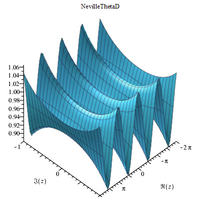From Wikipedia, the free encyclopedia
In mathematics, the Neville theta functions , named after Eric Harold Neville ,[1] [2] [3] [4]
θ
c
(
z
,
m
)
=
2
π
q
(
m
)
1
/
4
m
1
/
4
K
(
m
)
∑
k
=
0
∞
(
q
(
m
)
)
k
(
k
+
1
)
cos
(
(
2
k
+
1
)
π
z
2
K
(
m
)
)
{\displaystyle \theta _{c}(z,m)={\frac {{\sqrt {2\pi }}\,q(m)^{1/4}}{m^{1/4}{\sqrt {K(m)}}}}\,\,\sum _{k=0}^{\infty }(q(m))^{k(k+1)}\cos \left({\frac {(2k+1)\pi z}{2K(m)}}\right)}
θ
d
(
z
,
m
)
=
2
π
2
K
(
m
)
(
1
+
2
∑
k
=
1
∞
(
q
(
m
)
)
k
2
cos
(
π
z
k
K
(
m
)
)
)
{\displaystyle \theta _{d}(z,m)={\frac {\sqrt {2\pi }}{2{\sqrt {K(m)}}}}\,\,\left(1+2\,\sum _{k=1}^{\infty }(q(m))^{k^{2}}\cos \left({\frac {\pi zk}{K(m)}}\right)\right)}
θ
n
(
z
,
m
)
=
2
π
2
(
1
−
m
)
1
/
4
K
(
m
)
(
1
+
2
∑
k
=
1
∞
(
−
1
)
k
(
q
(
m
)
)
k
2
cos
(
π
z
k
K
(
m
)
)
)
{\displaystyle \theta _{n}(z,m)={\frac {\sqrt {2\pi }}{2(1-m)^{1/4}{\sqrt {K(m)}}}}\,\,\left(1+2\sum _{k=1}^{\infty }(-1)^{k}(q(m))^{k^{2}}\cos \left({\frac {\pi zk}{K(m)}}\right)\right)}
θ
s
(
z
,
m
)
=
2
π
q
(
m
)
1
/
4
m
1
/
4
(
1
−
m
)
1
/
4
K
(
m
)
∑
k
=
0
∞
(
−
1
)
k
(
q
(
m
)
)
k
(
k
+
1
)
sin
(
(
2
k
+
1
)
π
z
2
K
(
m
)
)
{\displaystyle \theta _{s}(z,m)={\frac {{\sqrt {2\pi }}\,q(m)^{1/4}}{m^{1/4}(1-m)^{1/4}{\sqrt {K(m)}}}}\,\,\sum _{k=0}^{\infty }(-1)^{k}(q(m))^{k(k+1)}\sin \left({\frac {(2k+1)\pi z}{2K(m)}}\right)}
where: K(m) is the complete elliptic integral of the first kind,
K
′
(
m
)
=
K
(
1
−
m
)
{\displaystyle K'(m)=K(1-m)}
q
(
m
)
=
e
−
π
K
′
(
m
)
/
K
(
m
)
{\displaystyle q(m)=e^{-\pi K'(m)/K(m)}}
Note that the functions θp (z,m) are sometimes defined in terms of the nome q(m) and written θp (z,q) (e.g. NIST[5] τ parameter θp (z|τ) where
q
=
e
i
π
τ
{\displaystyle q=e^{i\pi \tau }}
Relationship to other functions [ edit ] The Neville theta functions may be expressed in terms of the Jacobi theta functions[5]
θ
s
(
z
|
τ
)
=
θ
3
2
(
0
|
τ
)
θ
1
(
z
′
|
τ
)
/
θ
1
′
(
0
|
τ
)
{\displaystyle \theta _{s}(z|\tau )=\theta _{3}^{2}(0|\tau )\theta _{1}(z'|\tau )/\theta '_{1}(0|\tau )}
θ
c
(
z
|
τ
)
=
θ
2
(
z
′
|
τ
)
/
θ
2
(
0
|
τ
)
{\displaystyle \theta _{c}(z|\tau )=\theta _{2}(z'|\tau )/\theta _{2}(0|\tau )}
θ
n
(
z
|
τ
)
=
θ
4
(
z
′
|
τ
)
/
θ
4
(
0
|
τ
)
{\displaystyle \theta _{n}(z|\tau )=\theta _{4}(z'|\tau )/\theta _{4}(0|\tau )}
θ
d
(
z
|
τ
)
=
θ
3
(
z
′
|
τ
)
/
θ
3
(
0
|
τ
)
{\displaystyle \theta _{d}(z|\tau )=\theta _{3}(z'|\tau )/\theta _{3}(0|\tau )}
where
z
′
=
z
/
θ
3
2
(
0
|
τ
)
{\displaystyle z'=z/\theta _{3}^{2}(0|\tau )}
The Neville theta functions are related to the Jacobi elliptic functions . If pq(u,m) is a Jacobi elliptic function (p and q are one of s,c,n,d), then
pq
(
u
,
m
)
=
θ
p
(
u
,
m
)
θ
q
(
u
,
m
)
.
{\displaystyle \operatorname {pq} (u,m)={\frac {\theta _{p}(u,m)}{\theta _{q}(u,m)}}.}
θ
c
(
2.5
,
0.3
)
≈
−
0.65900466676738154967
{\displaystyle \theta _{c}(2.5,0.3)\approx -0.65900466676738154967}
θ
d
(
2.5
,
0.3
)
≈
0.95182196661267561994
{\displaystyle \theta _{d}(2.5,0.3)\approx 0.95182196661267561994}
θ
n
(
2.5
,
0.3
)
≈
1.0526693354651613637
{\displaystyle \theta _{n}(2.5,0.3)\approx 1.0526693354651613637}
θ
s
(
2.5
,
0.3
)
≈
0.82086879524530400536
{\displaystyle \theta _{s}(2.5,0.3)\approx 0.82086879524530400536}
θ
c
(
z
,
m
)
=
θ
c
(
−
z
,
m
)
{\displaystyle \theta _{c}(z,m)=\theta _{c}(-z,m)}
θ
d
(
z
,
m
)
=
θ
d
(
−
z
,
m
)
{\displaystyle \theta _{d}(z,m)=\theta _{d}(-z,m)}
θ
n
(
z
,
m
)
=
θ
n
(
−
z
,
m
)
{\displaystyle \theta _{n}(z,m)=\theta _{n}(-z,m)}
θ
s
(
z
,
m
)
=
−
θ
s
(
−
z
,
m
)
{\displaystyle \theta _{s}(z,m)=-\theta _{s}(-z,m)}

























